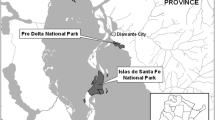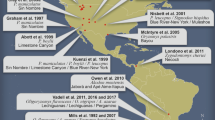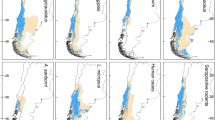Abstract
Rodent-borne hantaviruses are a group of zoonotic agents that cause hemorrhagic fever in humans. The transmission of hantaviruses among rodent hosts may be higher with the increase of reservoir host abundance in a given area (density-dependent transmission) and with the decrease of small mammal diversity (dilution effect phenomenon). These population and community parameters may be modified by habitat fragmentation; however, studies that focus on fragmentation and its effect on hantavirus infection risk are scarce. To further understanding of this issue, we assessed some population and community responses of rodents that may increase the risk for hantavirus transmission among wildlife hosts in the Americas. We conducted a meta-analysis of published studies to assess the responses of small mammals to fragmentation of native habitats, relative to patch size. Our analyses included five countries and 14 case studies for abundance of reservoir hosts (8 species) and 15 case studies for species richness. We found that a reduction of patch area due to habitat fragmentation is associated with increased reservoir host abundances and decreased small mammal richness, which is mainly due to the loss of non-host small mammals. According to these results, habitat fragmentation in the Americas should be considered as an epidemiological risk factor for hantavirus transmission to humans. These findings are important to assess potential risk of infection when fragmentation of native habitats occurs.


Similar content being viewed by others
References
Abbott KD, Ksiazek TG, and Mills JN (1999) Long-term hantavirus persistence in rodent populations in central Arizona. Emerging Infectious Diseases 5:102-112
Arnqvist G, and Wooster D (1995) Meta-analysis: synthesizing research findings in ecology and evolution. Trends in Ecology & Evolution 10:236-240
Begon M, Bennett M, Bowers R, French N, Hazel S, and Turner J (2002) A clarification of transmission terms in host-microparasite models: numbers, densities and areas. Epidemiology and Infection 129:147-153
Blasdell K, Cosson JF, Chaval Y, Herbreteau V, Douangboupha B, Jittapalapong S, et al. (2011) Rodent-Borne Hantaviruses in Cambodia, Lao PDR, and Thailand. EcoHealth 8:432-443
Boone JD, Otteson EW, McGwire KC, Villard P, Rowe JE, and St Jeor SC (1998) Ecology and demographics of hantavirus infections in rodent populations in the Walker River Basin of Nevada and California. American Journal of Tropical Medicine and Hygiene 59:445-451
Brady MJ, McAlpine CA, Possingham HP, Miller CJ, and Baxter GS (2011) Matrix is important for mammals in landscapes with small amounts of native forest habitat. Landscape Ecology 26:617-628
Brooks TM, Mittermeier RA, Mittermeier CG, Da Fonseca GA, Rylands AB, Konstant WR, et al. (2002) Habitat loss and extinction in the hotspots of biodiversity. Conservation Biology 16:909-923
Carver S, Kuenzi A, Bagamian KH, Mills JN, Rollin PE, Zanto SN, et al. (2011a) A temporal dilution effect: hantavirus infection in deer mice and the intermittent presence of voles in Montana. Oecologia 166:713-721
Carver S, Trueax JT, Douglass R, and Kuenzi A (2011b) Delayed density-dependent prevalence of Sin Nombre virus infection in deer mice (Peromyscus maniculatus) in central and western Montana. Journal of Wildlife Diseases 47:56-63
Clay CA, Lehmer EM, Jeor SS, and Dearing MD (2009) Sin Nombre Virus and Rodent Species Diversity: A Test of the Dilution and Amplification Hypotheses. Plos One 4:e6467
Cruz CD, Forshey BM, Vallejo E, Agudo R, Vargas J, Blazes DL, et al. (2012) Novel strain of Andes virus associated with fatal human infection, central Bolivia. Emerging Infectious Diseases 18:750-757
Debinski DM (2006) Forest fragmentation and matrix effects: the matrix does matter. Journal of Biogeography 33:1791-1792
Dearing MD, and Dizney L (2010) Ecology of hantavirus in a changing world. Annals of the New York Academy of Sciences 1195:99-112
Dizney LJ, and Ruedas LA (2009) Increased Host Species Diversity and Decreased Prevalence of Sin Nombre Virus. Emerging Infectious Diseases 15:1012-1018
Dobson AP, and Hudson PJ. (1995) Microparasites: Observed patterns in wild animal populations. In: Ecology of infectious diseases in natural populations, Grenfell BT, Dobson A (editors), Cambridge, UK: Cambridge University Press, pp 52–89
Douglass RJ, Wilson T, Semmens WJ, Zanto SN, Bond CW, Van Horn RC, et al. (2001) Longitudinal studies of Sin Nombre virus in deer mouse-dominated ecosystems of Montana. American Journal of Tropical Medicine and Hygiene 65:33-41
Escutenaire S, Thomas I, Clement J, Verhagen R, Chalon P, and Pastoret PP (1997) Hantavirus epidemiology in red bank voles (Clethrionomys glareolus). Annales de Medecine Veterinaire 141:471-476
Ewers RM, and Didham RK (2006) Confounding factors in the detection of species responses to habitat fragmentation. Biological Reviews 81:117-142
Fahrig L (2003) Effects of habitat fragmentation on biodiversity. Annual Review of Ecology Evolution and Systematics 34:487-515
Guo W-P, Lin X-D, Wang W, Tian J-H, Cong M-L, Zhang H-L, et al. (2013) Phylogeny and origins of hantaviruses harbored by bats, insectivores, and rodents. Plos Pathogens 9:e1003159
Gurevitch J, and Hedges VL (2001) Meta-analysis: combining the results of independent experiments. In: Design and analysis of ecological experiments, Scheiner SM, Gurevitch J (editors), New York: Oxford University Press, pp 347–369
Hedges LV, and Olkin I (1985) Statistical methods for meta-analysis. Boston: Academic Press
Hjelle B, and Torres-Pérez F (2010) Hantaviruses in the Americas and their role as emerging pathogens. Viruses 2:2559-2586
Jonsson CB, Moraes Figueiredo LT, and Vapalahti O (2010) A Global Perspective on Hantavirus Ecology, Epidemiology, and Disease. Clinical Microbiology Reviews 23:412-441
Kariwa H, Yoshida H, Sanchez-Hernandez C, de Lourdes Romero-Almaraz M, Alberto Almazan-Catalan J, Ramos C, et al. (2012) Genetic diversity of hantaviruses in Mexico: Identification of three novel hantaviruses from Neotominae rodents. Virus Research 163:486-494
Keesing F, Holt RD, and Ostfeld RS (2006) Effects of species diversity on disease risk. Ecology Letters 9:485-498
Langlois JP, Fahrig L, Merriam G, and Artsob H (2001) Landscape structure influences continental distribution of hantavirus in deer mice. Landscape Ecology 16:255-266
Lee H, Bark D, Baek L, Choi K, Whang Y, and Woo M (1980) Korean hemorrhagic fever patients in urban areas of Seoul. Korean Journal of Virology 10:1-6
Lobos G, Ferres M, and Palma RE (2005) Presencia de los géneros invasores Mus y Rattus en áreas naturales de Chile: un riesgo ambiental y epidemiológico. Revista Chilena de Historia Natural 78:113-124
Mackelprang R, Dearing MD, and St Jeor S (2001) High prevalence of Sin Nombre virus in rodent populations, central Utah: a consequence of human disturbance? Emerging Infectious Diseases 7:480-482
Madhav NK, Wagoner KD, Douglass RJ, and Mills JN (2007) Delayed density-dependent prevalence of Sin Nombre virus antibody in Montana deer mice (Peromyscus maniculatus) and implications for human disease risk. Vector-Borne and Zoonotic Diseases 7:353-364
Matheus S, Lavergne A, de Thoisy B, Dussart P, and Lacoste V (2012) Complete genome sequence of a novel hantavirus variant of Rio Mamore virus, Maripa virus, from French Guiana. Journal of Virology 86:5399-5399
Markl J, Schleuning M, Forget P, Jordano P, Lambert J, Traveset A, et al. (2012) Meta-analysis of the effects of human disturbance on seed dispersal by animals. Conservation Biology 26:1072-1081
Mills JN, Ksiazek TG, Peters C, and Childs JE (1999) Long-term studies of hantavirus reservoir populations in the southwestern United States: a synthesis. Emerging Infectious Diseases 5:135-142
Myers SS, Gaffikin L, Golden CD, Ostfeld RS, Redford KH, Ricketts TH, et al. (2013) Human health impacts of ecosystem alteration. Proceedings of the National Academy of Sciences 110:18753-18760
Niklasson B, Hornfeldt B, Lundkvist A, Bjorsten S, and Leduc J (1995) Temporal dynamics of Puumala virus antibody prevalence in voles and of nephropathia epidemica incidence in humans. The American Journal of Tropical Medicine and Hygiene 53:134-140
Olsson GE, White N, Ahlm C, Elgh F, Verlemyr AC, Juto P, et al. (2002) Demographic factors associated with hantavirus infection in bank voles (Clethrionomys glareolus). Emerging Infectious Diseases 8:924-929
Ostfeld RS, and Keesing F (2012) Effects of Host Diversity on Infectious Disease. Annual Review of Ecology, Evolution, and Systematics 43:157-182
Pardini R (2004) Effects of forest fragmentation on small mammals in an Atlantic Forest landscape. Biodiversity & Conservation 13:2567-2586
Prugh LR, Hodges KE, Sinclair AR, and Brashares JS (2008) Effect of habitat area and isolation on fragmented animal populations. Proceedings of the National Academy of Sciences 105:20770-20775
Rosenberg MS, Adams DC, and Gurevitch J (2000) MetaWin: statistical software for meta-analysis. Sunderland, Massachusetts: Sinauer Associates
Rosenthal R (1979) The file drawer problem and tolerance for null results. Psychological Bulletin 86:638-641
Ruedas LA, Salazar-Bravo J, Tinnin DS, Armién B, Cáceres L, García A, et al. (2004) Community ecology of small mammal populations in Panama following an outbreak of Hantavirus pulmonary syndrome. Journal of Vector Ecology 29:177-191
Suzán G, Armien A, Mills JN, Marce E, Ceballos G, Avila M, et al. (2008) Epidemiological considerations of rodent community composition in fragmented landscapes in Panama. Journal of Mammalogy 89:684-690
Suzán G, Marce E, Giermakowski JT, Mills JN, Ceballos G, Ostfeld RS, et al. (2009) Experimental Evidence for Reduced Rodent Diversity Causing Increased Hantavirus Prevalence. Plos One 4:e5461
Suzán G, Esponda F, Carrasco-Hernández R, and Aguirre AA (2012) Habitat Fragmentation and Infectious Disease Ecology. In: New Directions in Conservation Medicine: Applied Cases of Ecological Health, Aguirre, AA, Ostfeld RS, Daszak (editors), New York: Oxford University Press, pp 135-150
Tersago K, Schreurs A, Linard C, Verhagen R, Van Dongen S, and Leirs H (2008) Population, environmental, and community effects on local bank vole (Myodes glareolus) Puumala virus infection in an area with low human incidence. Vector-Borne and Zoonotic Diseases 8:235-244
Vargas RR, Fontúrbel FE, Bonacorso E, and Simonetti JA (2012) Variation in reproductive life-history traits of birds in fragmented habitats: a review and meta-analysis. Bird Conservation International 22:462-467
Voutilainen L, Savola S, Kallio ER, Laakkonen J, Vaheri A, Vapalahti O, et al. (2012) Environmental Change and Disease Dynamics: Effects of Intensive Forest Management on Puumala Hantavirus Infection in Boreal Bank Vole Populations. Plos One 7:e39452
Wang H, Yoshimatsu K, Ebihara H, Ogino M, Araki K, Kariwa H, et al. (2000) Genetic Diversity of Hantaviruses Isolated in China and Characterization of Novel Hantaviruses Isolated from Niviventer confucianus and Rattus rattus. Virology 278:332-345
Yahnke CJ, Meserve PL, Ksiazek TG, and Mills JN (2001) Patterns of infection with Laguna Negra virus in wild populations of Calomys laucha in the central Paraguayan chaco. American Journal of Tropical Medicine and Hygiene 65:768-776
Yates TL, Mills JN, Parmenter CA, Ksiazek TG, Parmenter RR, Vande Castle JR, et al. (2002) The ecology and evolutionary history of an emergent disease: Hantavirus pulmonary syndrome. Bioscience 52:989-998
Zhang Y, Yuan J, Yang X, Zhou J, Yang W, Peng C, et al. (2011) A novel hantavirus detected in Yunnan red-backed vole (Eothenomys miletus) in China. Journal of General Virology 92:1454-1457
Zeitz PS, Butler JC, Cheek JE, Samuel MC, Childs JE, Shands LA, et al. (1995) A case-control study of hantavirus pulmonary syndrome during an outbreak in the southwestern United States. Journal of Infectious Diseases 171:864-870
Acknowledgments
We thank the Disease Ecology Group (FMVZ, UNAM), Gerardo Ceballos, Rurik List, Catherine Machalaba, and two anonymous reviewers for comments and suggestions that improved this manuscript, and the Postgraduate Program (FMVZ, UNAM) for support. We are grateful to Carolyn Brown and Kendra Shannon (UNAM-Canada) for reviewing the English of an early version of this manuscript. A.V. Rubio is supported by a CONICYT Becas-Chile Scholarship.
Author information
Authors and Affiliations
Corresponding author
Electronic supplementary material
Below is the link to the electronic supplementary material.
Rights and permissions
About this article
Cite this article
Rubio, A.V., Ávila-Flores, R. & Suzán, G. Responses of Small Mammals to Habitat Fragmentation: Epidemiological Considerations for Rodent-Borne Hantaviruses in the Americas. EcoHealth 11, 526–533 (2014). https://doi.org/10.1007/s10393-014-0944-9
Received:
Revised:
Accepted:
Published:
Issue Date:
DOI: https://doi.org/10.1007/s10393-014-0944-9




